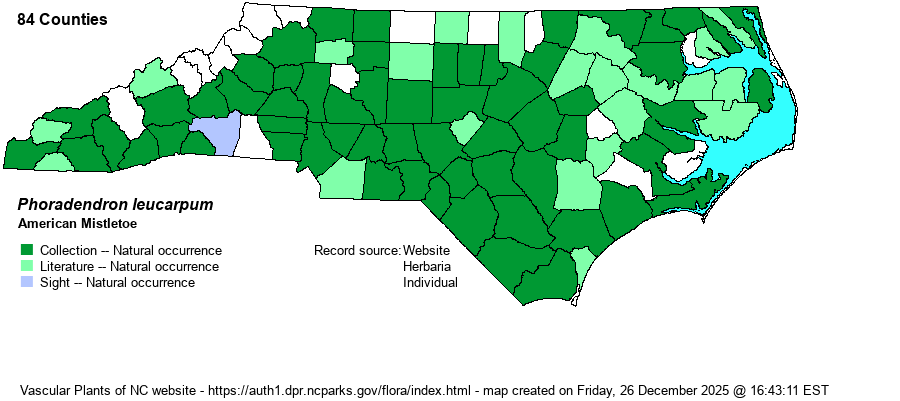| Author | (Rafinesque) Reveal & M.C. Johnston | |
| Distribution | Occurs over all of the Coastal Plain and Piedmont, but of spotty occurrence in the Mountains. Likely absent in a few northern Mountain counties. Though of scattered distribution in the eastern Coastal Plain, it likely is present in all counties there. As this species usually grows high on tree limbs, the scarcity of records for many counties in the Coastal Plain and Piedmont likely is related to the difficulty of collecting it, often in swampy conditions.
This has a wide east-west range, from NJ and FL west to the Pacific Coast in OR and CA. It thus occurs over most of the southern 40% of the country.
| |
| Abundance | Generally common in the Coastal Plain; fairly common to locally common in the Piedmont; uncommon in the Mountains, mainly at low elevations. Often more common or easily seen on large trees along city streets than in extensive forests. | |
| Habitat | This is a parasitic species that grows on limbs of deciduous trees, especially oaks – the larger the trees the better. It often occurs in swamps and bottomlands, but it also can be found on trees along streets in towns and cities, well removed from moist forests. Thus, it has no distinct habitats, but it is seldom found on small trees, and thus places with trees 70 feet tall or taller are favored. |
| Phenology | Flowers (hardly noticed) in late fall, and fruits from November into January, and sporadically later. The fruits are often eaten by birds, especially Cedar Waxwings; as the seeds are passed through the digestive system of the birds, they stick to branches on the trees owing to a sticky pulp. | |
| Identification | This is a unique species, like no other in the eastern U.S. It is often considered (incorrectly) as an epiphyte, but it gets some nourishment from the trees on which it grows (i.e., is a parasite), though the trees are seldom killed by the Mistletoe. It grows as an evergreen “bush”, about 1-2 feet across, with many branches in a rounded shape – easily visible on bare branches of tall deciduous trees in late fall and winter. The leaves are thick and waxy, with an elliptical shape, and are about 1-inch long on average. In winter, the small, rounded berries, which are a waxy white color, can be seen. In some cases, they can be seen on your car, if the car sits below a tree in which birds have “pooped” on your car. Of course, this shrub is widely used in Christmas festivities, though it is usually difficult to reach the plants in the trees; normally, you must find shrubs that have blown down from the trees or found on broken limbs on the ground. | |
| Taxonomic Comments | The species was formerly named as Phoradendron flavescens and also as P. serotinum (in RAB 1968). Weakley (2018) and others have the species split into several subspecies, not surprising given its very wide range; the taxon here is listed as P. leucarpum ssp. leucarpum.
| |
| Other Common Name(s) | Eastern Mistletoe, Oak Mistletoe, Hairy Mistletoe | |
| State Rank | S5 | |
| Global Rank | G5 | |
| State Status | | |
| US Status | | |
| USACE-agcp | | |
| USACE-emp | | |

